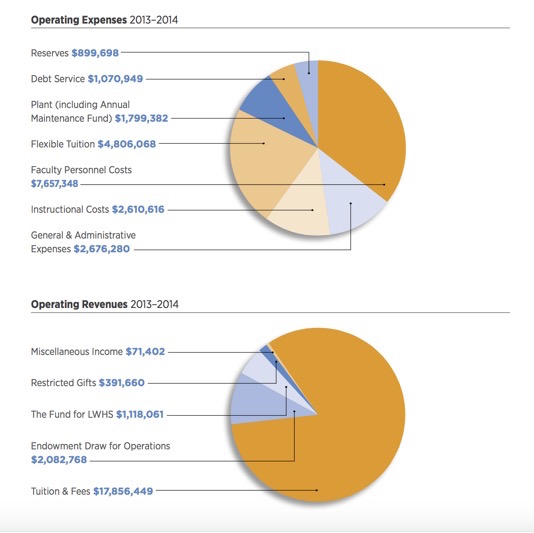Lick-Wilmerding’s budget is more than 20 million dollars a year. It costs $20 million to maintain a large campus, provide opportunities for families to receive flexible tuition, provide supplies and meals for more than 490 students and adults, and pay an extensive and well-trained group of over 100 faculty and staff a competitive wage. Running a school like Lick is no small venture.
The budget is established through the continuous work of board committees, administrators, the business office, and requests from all departments. “It is a huge effort by many different people to balance a budget like this every year,” informed Melanie Johnson, the school’s Chief Financial Officer. Many hours go into our school’s complex budget. The school is constantly growing, and each facet of the school must have its budget managed and reworked every year.
 Managing and investing the school’s endowment in a responsible manner, Johnson explains, is an essential part to meeting Lick’s financial needs. Lick’s endowment is around $50 million, and is overseen by a board committee in order to keep the school running effectively for generations to come. Johnson says “The principal [of the endowment] has to be saved. Only the income from its investment along with other amounts can be spent based on an approved spending rate.” The school is able to draw on about two million dollars of income every year to support the needs of students.
Managing and investing the school’s endowment in a responsible manner, Johnson explains, is an essential part to meeting Lick’s financial needs. Lick’s endowment is around $50 million, and is overseen by a board committee in order to keep the school running effectively for generations to come. Johnson says “The principal [of the endowment] has to be saved. Only the income from its investment along with other amounts can be spent based on an approved spending rate.” The school is able to draw on about two million dollars of income every year to support the needs of students.
It might seem as if the school’s $41,500 a year tuition would be plenty to keep the school running, but Head of School Eric Temple explains how keeping the tuition manageable and the school funded is a constant challenge. “The CPI has been going up 3%, and our tuition has gone up 3.8-4.8% every year,” he explains. The CPI is the Consumer Price Index, the measurement of the price level of basic consumer goods. This means that seemingly large increases in revenue may do little more than keep pace with rising inflation. Temple emphasizes the vital role that fundraising plays to maintain our school’s budget. “Around 7% of the budget comes from fundraising,” he explains. Temple is encouraged by the frequency of donations to the school. He says donations are a way for people to feel like they are a part of the school and give to an organization they believe in, as well as receiving a tax deduction tied to donations to non-profits. “Something that I feel is important for students to remember is that our school is a non-profit, and that means that we rely on donations in order to survive,” he said.
One of the highest priorities for our school’s funding, as told by both Johnson and Temple, is flexible tuition. The flexible tuition program allows families who need support to receive financial help to supplement their student’s tuition. Around five million dollars is spent on the flex tuition program each year. Johnson estimated that around 37% of families participate in this program. Temple explained how the flex tuition program allows our school to fulfill one of its most important missions, providing for students of all backgrounds. “The flexible tuition program is really vital to our school… Part of the reason that so many families want to apply to our school is because they do feel like, ‘Oh, I actually have a shot’, and that is something we need to keep alive.” He also made clear how many donors sympathize strongly with the flex tuition program. “People are always really generous and understanding when it comes to the flex tuition program. It’s wonderful to see.”
The majority of the school’s budget goes to paying salaries. “We are a people driven organization,” Temple explains. “Our faculty are the heart of the school, and of course we wouldn’t be able to run without them.” He explained to me how the school makes a constant effort to keep salaries competitive with national benchmarks, particularly benchmarks in the Bay Area. “Salaries are currently in the top 25% of independent schools like ours” he said.





